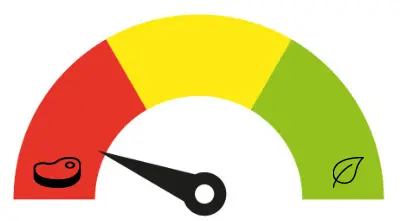Answer: No.

Art supplies traditionally use a few ingredients obtained from slaughtered or trapped animals. For example, mediums, paints, and papers contain bone char, ox gall, gelatin, rabbit collagen, carmine, eggs, and shellac. Natural paintbrushes are created from the hair of pigs, sables, and squirrels. So, the question here is, are Crayola crayons vegan?
It will be shocking for some people to know that creating crayons requires the usage of animal fat. Crayola crayons are not vegan as they are produced using stearic acid. Stearic acid can be obtained from either plant or animal sources. Moreover, Crayola has stated that it is animal-delivered.
People often presume that to go vegan, all they have to do is stop eating and wearing animals. However, you will be surprised to know that many surprising foods and items contain non-vegan by-products that you’d have never imagined!
Some of the foods and items that are not vegan-friendly are beer, perfumes, plastic bags, downy, sugar, nail polish, cigarettes, and crayons. What an odd combination of items, isn’t it?
Today, we will tell you all about one such art supply called Crayola crayons and how it is not vegan-friendly. Read on to find out more!
Table of Contents
What Are Crayola Crayons Made Of?
Most crayons need paraffin as the main ingredient, but we are sure you wouldn’t expect a mammalian by-product in an art supply for children. Let’s take a look at what and how Crayola crayons are made of.
We cannot give you the actual ingredients used in Crayola crayons because it is a company’s trade secret and is not made available to the public. However, Crayola claims that the essential elements used in Crayola crayons are color pigment and paraffin wax.
The same ingredients are used for all Crayola Crayon colors with tiny modifications for special effect crayons. It is unclear whether or not any additional ingredients go into color pigments.
Some other additional ingredients that are possibly used in creating Crayola crayons include peanuts, legumes, tree nuts, nuts, red dye, latex, and milk casein.
Although Crayola prints “non-toxic” on the crayon boxes, it is merely a technicality. It just means that one crayon doesn’t have enough to be considered toxic. There may be poisonous ingredients contained within.
Importantly, paraffin wax is made of petroleum, oil shale, or coal. The process through which paraffin wax is created is likely to expose it to several toxic ingredients which don’t get purified in the melting process.
Crayola has withheld from disclosing their unique secret to the world. However, these are the potential ingredients that could be a part of the crayons:
- Stearic acid
- Tallow (beef)
- Filler (talc, kaolin)
How Are Crayola Crayons Manufactured?
To manufacture Crayola crayons, the paraffin wax is melted and mixed with color pigments. This mixture of hot wax is then poured into molding machines. In the next 4-7 minutes, the crayons cool down and solidify.
Why Are Crayola Crayons Not Vegan?
Crayola is embedded deeply in popular culture. A study conducted showed that 99% of households recognized Crayola as a brand name. Crayola has remained a staple for over 100 years. They have fostered creativity and kept children at ease all over the world.
However, there are certain aspects of Crayola crayons that may not sound very appealing to vegans. Let’sLet’s take a look at why Crayola crayons are not vegan.
The Distinctive Crayola Smell Is Beef Fat
If you have ever smelt a Crayola crayon, you would recognize the smell with closed eyes if need be. This was the premise of an experiment in 1982.
In a study conducted by Professor William Cain of Yale University, it was found that Crayola crayons were among the top 20 smells that most subjects identified. As we mentioned previously, stearic acid is the element used to manufacture most crayons.
Crayola crayons are no exception to that. Stearic acid is derived from beef tallow which is commonly known as beef fat. This ingredient finds its usage in delivering a waxy consistency.
So, that smell we so strongly associate with is the smell of processed beef fat! And this – is not vegan-friendly! We bet you formed that deduction already.
Why Is Beef Fat or Stearic Acid Used in Crayola Crayons?
Whenever people have reached out to Crayola about the ingredients of their crayons, Crayola has denied revealing their secret recipe. However, they have stated that a variety of Crayola products contain animal by-products.
We are sure that just like us, you, too, are wondering why beef fat or stearic acid is required to manufacture crayons at all? Well, let us tell you that stearic acid makes the crayons stronger.
Stearic acid – a derivative of beef fat-is a long saturated fatty acid to get a little more technical. If you think what that means, well, here it is! It means that this acid becomes a waxy solid at room temperature.
The presence of the carboxyl group gives this acid the ability to create esters with glycerol. This means that you can stick three of them together. With this process, stearic acid becomes an excellent hardening agent for organic molecules.
This is why you find stearic acid in soaps, candles, detergents, and crayons. Stearic acid stabilizes finished products and ensures that they stay like they are meant to. Stearic acid is either made of vegetable oils or animal fats.
We can rule out the possibility of this acid being vegetable-oil-based as Crayola has agreed that some of their products contain animal fat. Thus, the stearic acid used in Crayola crayons is animal-derived.
How Much Stearic Acid Goes Into Crayola Crayons?
As we have mentioned above, Crayola uses paraffin wax and color pigments in its crayons. Crayola does not give us the complete list of ingredients due to it being a proprietary trade secret.
So, the best we can do is guess a third-party assessment. Most ingredients listed on the products are given according to their weight in descending order. Thus, the paraffin wax and color pigments used in Crayola crayons make up at least 80% of the product by weight.
This leaves us with 20% for the remaining ingredients. Tallow or stearic acid will likely be this remaining 20% or maybe even 10-15%. This stearic acid gives these crayons the characteristic aroma we all have etched in our noses and memories!
Alternatives to Crayola Crayons
More often than not, we notice that little children eat chalk or crayons simply because they smell nice. It is, obviously, unadvisable to do that due to the substances used in the creation of these products.
However, if you have adopted the vegan lifestyle in its most authentic essence, here are a couple of alternatives that you can use instead of Crayola crayons:
- Azafran Crayons: The Azafran crayons produced by Azafran are absolutely vegan and are available on Amazon.
- Wee Can Too Crayons: The Veggie Baby Crayons produced by Wee Can Too have vegan-friendly ingredients. They are available on the Wee Can Too website.
- Doug and Melissa Crayons: The Doug and Melissa Crayons are made from plastic and feel a little different than standard Crayola crayons. However, they are 100% vegan. Although these colors are slightly more expensive than a typical Crayola box, they’re still affordable.
Wrapping Up
If you genuinely want to adopt veganism as a lifestyle, we are sure that you will be cautious of your choices, even when it comes to crayons.
However, there are many alternatives to Crayola crayons that you can consider if you don’t find Crayola as appealing anymore. There is no doubt about Crayola not being vegan because Crayola has clearly stated that the stearic acid used by them is animal-derived. Nevertheless, Crayola has stayed with us for as long as we can remember.
Nonetheless, with the rise of veganism, people like us tend to make life-altering choices in all aspects of our lives. Other crayons use stearic acid which is derived from plants.
Many high-end companies that manufacture art supplies use ingredients obtained from animals. One reason for this is that they have been following such practices for hundreds of years, leading to these traditional recipes.
However, traditional doesn’t always mean better. There are many art supplies like the few listed above, which are absolutely vegan-friendly. If you genuinely want to effect change as a vegan, we are sure you will consider what we have just told you!
If you have questions regarding an art supply company similar to Crayola crayons vegan, all you have to do is reach out to them for clarification. Crayola, however, has clarified that they use animal by-products to manufacture some of their products.

